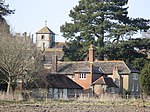Wiston House
1576 establishments in EnglandCountry houses in West SussexGrade I listed buildings in West SussexHorsham DistrictHouses completed in 1576

Wiston House is a 16th-century Grade I listed building set in the South Downs National Park on the south coast of England, surrounded by over 6,000 acres (2,400 ha) of parkland in Wiston, West Sussex. It is the home of Wilton Park, an executive agency of the Foreign and Commonwealth Office. Originally built in two storeys to an irregular floor plan, substantial parts of the house have since been demolished and replaced and additional wings added. It is a Grade I listed building.
Excerpt from the Wikipedia article Wiston House (License: CC BY-SA 3.0, Authors, Images).Wiston House
Mouse Lane,
Geographical coordinates (GPS) Address Nearby Places Show on map
Geographical coordinates (GPS)
| Latitude | Longitude |
|---|---|
| N 50.899722222222 ° | E -0.35888888888889 ° |
Address
Mouse Lane
BN44 3DZ
England, United Kingdom
Open on Google Maps








